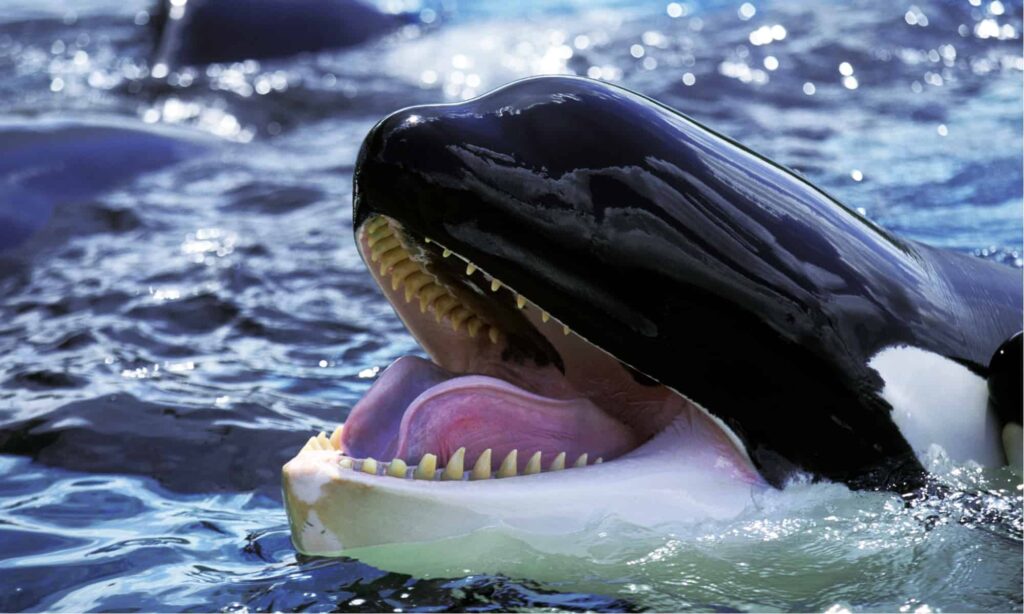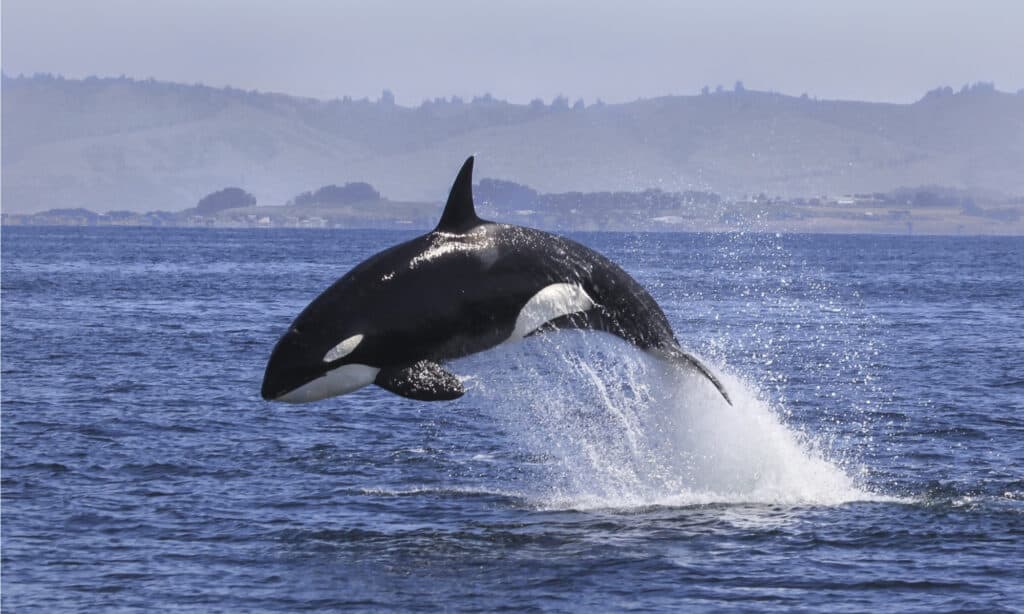Despite practically never attacking humans, orcas are frequently referred to as killer whales. According to Whale and Dolphin Conservation, the killer whale’s original moniker, “whale killer,” derived from when old sailors from several decades ago observed them hunting in packs to kill huge whales.
Orcas are one of the mammals and whales that live throughout the world’s oceans. They are ferocious marine predatory animals, outgoing, omnivorous, and aggressive, devouring anything from seals to a variety of sharks.
Although there are several species of whales in the ocean, orcas are easily identifiable due to their unique coloring. Their iconic, glossy, black blubber complements a white marking behind each eye and on their bellies.
Why Do Orcas Have White Spots?

Killer whales have razor-sharp teeth!
©slowmotiongli/Shutterstock.com
The main benefit of orcas having white patches is that they can use them as camouflage to avoid any prey noticing them. The orcas’ white belly and black upper body allow them to camouflage into their surroundings because animals below them might think they are seeing sunshine reflecting off of them rather than a hungry orca.
As a result, orcas are less obvious from both above and below, enabling them to approach their prey undetected. Furthermore, since every orca has a distinctive pattern of pigmentation, the white spots on an individual orca may aid in interpersonal interaction and recognition among the whales.
As the killer whale ages, the spots may alter significantly in dimensions, form, and position on the body. This aids in both the orcas’ ability to distinguish between one another and the researcher’s capacity to track and accurately distinguish orcas within a pod.
Do All Orcas Have White Markings?
All killer whales do, in fact, have white patches. They feature a white underside, a white saddle area that is situated right below their dorsal fins, and a pair of white eye spots that are just above each of their eyes.
Most people think that there are white spots on the orca’s head. Instead, they have tiny eyes that you can find just in front of the white eye patch.
Benefits of White Spots on Orcas

The white markings on orcas allow them to camouflage.
©slowmotiongli/Shutterstock.com
The ability to blend in is crucial in the wild. It enables hunters to approach their prey covertly before making the kill. White patches on orcas may indicate that their prey is unaware of them when they chase seals, penguins, squid, or any of the numerous other creatures that they eat.
Because they are dark in color on the top portion of their bodies, orcas may go undetected by land-based prey like penguins or seals. The orcas appear like natural sunshine from underneath and also blend in with the bottom of the ocean from above due to their white patches.
Inferring that these white patches are just the sun’s reflection, wildlife that dwells on the ocean floor like octopuses and rays may approach the orcas. Before they have a moment to react, the killer whale has found its next meal.
It is also harder for animals to recognize an orca because of its white patches because they blur the contours of its body. The white markings on orcas help to significantly obscure them from predators and prey alike.
All About the Eye of an Orca
Just like humans, orcas can have varying eye shades within their own species. Their eyes might be red, brown, or blue. One can typically observe these whales swimming in places of the water that are deep and gloomy.
The size of a killer whale’s eye can reach three inches. Their eyesight is just as important to them as their hearing, despite the fact that orcas are thought to have a better sense of hearing. Orcas have exceptional vision both in and out of the water.
Are Orcas Dangerous to Humans?

Orcas can lift their entire bodies out of the water when they breach.
©Tory Kallman/Shutterstock.com
In contrast to sharks, killer whales rarely attack humans if they’re not feeling threatened, and no known instance of a human being being devoured by an orca has ever occurred. At least from what we know and have on record, killer whales are generally friendly creatures toward people. However, unless under expert supervision in a confined space, it is not advisable to approach killer whales.
It’s unclear if they avoid attacking humans because we lack the appearance of any of the prey animals they often eat, or because we don’t have an appealing flavor to them. Either way, we’re not complaining! We will be happy to keep the peace between humans and orcas!
The photo featured at the top of this post is © Petr Slezak/Shutterstock.com
Thank you for reading! Have some feedback for us? Contact the AZ Animals editorial team.







